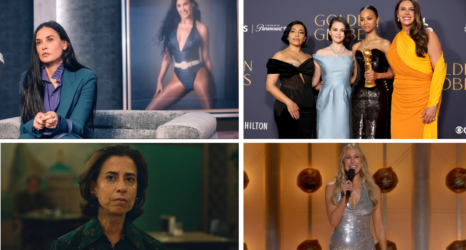Amidst the pomp and circumstance of the 72nd Annual Golden Globe Awards Sunday night, it’s easy to get swept up in the opulence that is Hollywood and not look behind the shiny veneer of the television and film industry.
While there was deserved hoopla over the feminist moments of the evening, with wins for up-and-comer Gina Rodriguez for her breakout series Jane the Virgin; Downton Abbey’s Joanne Froggatt for her portrayal of a rape victim on the PBS drama’s fourth season; and comedy chieftains Tina Fey and Amy Poehler at the helm of the awards show; a recent report reveals the gender disparity for people working behind the cameras.
Despite premature celebrations that the glass ceiling had been shattered for female directors after director Kathryn Bigelow won two Academy Awards for The Hurt Locker in 2009 (and a Best Picture nomination for Zero Dark Thirty in 2013), the report indicates that women comprise just 7 percent of directors working on the top 250 films of 2014.
“The findings drive home the point that men continue to construct the vast majority of the visual and aural worlds featured in U.S. films,” says Martha Lauzen, executive director at the Center for the Study of Women in Television and Film at San Diego State University, which published The Celluloid Ceiling: Behind-the-Scenes Employment of Women on the Top 250 Films of 2014.
The annual study, now in its 17th year, further reveals that the number of women who “comprised all directors, writers, producers, executive producers, editors and cinematographers” credited on the top 250 (domestic) grossing films was 17 percent—the same as when the study began back in 1998.
While marginal strides are being made for women on screen—four of the nine Best Picture nominees from last year’s Academy Awards at least passed the Bechdel test—it’s just as, if not more, important to be critical of the myriad ways women take part behind the scenes.
Only 11 percent of writers employed last year on the highest grossing movies were women—which makes one wonder if writers’ rooms at Warner Brothers, 20th Century Fox and Universal have “No Girls Allowed” signs written in crayon taped to the front.
It’s even worse for women providing the soundtracks for the movies we watch. Says Lauzen,
Because music and sound play such an important role in the movie-going experience, this year’s study also reports figures for women working as composers, sound designers, and supervising sound editors. Women comprised 1 percent, 5 percent and 5 percent of individuals working in these roles respectively.
To be fair, Lauzen’s study did show some incremental progress for women: 19 percent of the executive producers on the top films of 2014 were women, the highest it’s been since the study began (though up only a marginal 1 percent from the 1998 study). Women also made up 23 percent of the producers on last year’s biggest blockbusters—which is relatively good, in comparison to other behind-the-scenes categories, but is 2 percent lower than in 2013.
Of course we were also excited that Ava DuVernay became the first black woman ever to be nominated for Best Director at the Golden Globes, but so far she is an outlier, not representative of a trend.
On Thursday, the Academy of Motion Picture Arts and Sciences will unveil its 2015 Oscar nominations. Though the Golden Globes has, in years past, served as a helpful predictor to place our bets on the yearly Oscar race, Lauzen’s study allows us to peek behind the red velvet curtain sooner, adjust our eyes to the bright lights and see just how far women in Hollywood still have to go to break through the perennial “celluloid ceiling.”
Photo of Ava DuVernay courtesy of Marion Curtis, licensed under Creative Commons 2.0





